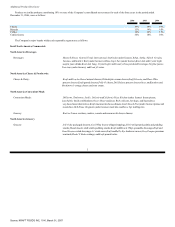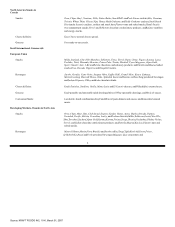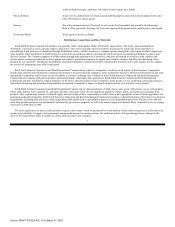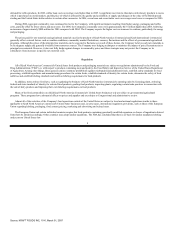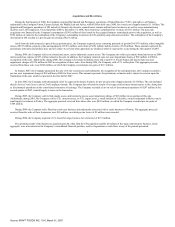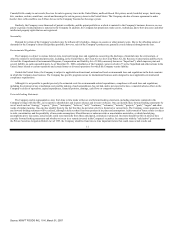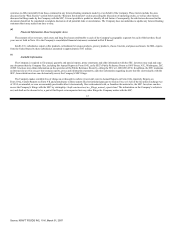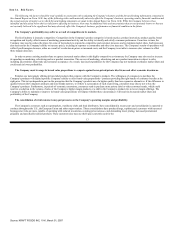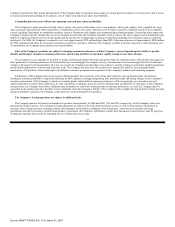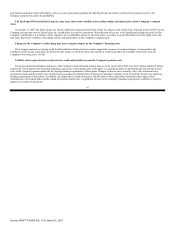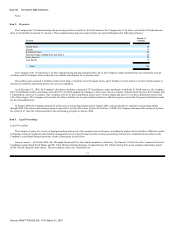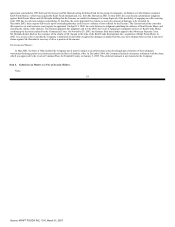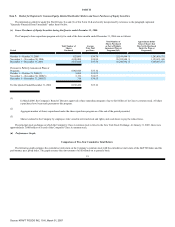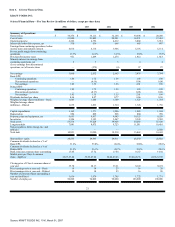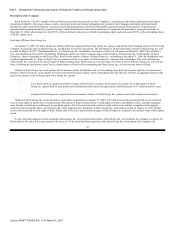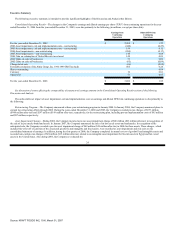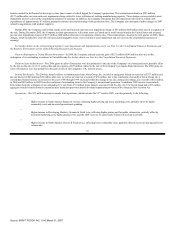Kraft 2006 Annual Report Download - page 19
Download and view the complete annual report
Please find page 19 of the 2006 Kraft annual report below. You can navigate through the pages in the report by either clicking on the pages listed below, or by using the keyword search tool below to find specific information within the annual report.
exchange rates prevailing during a reporting period. During times of a strengthening U.S. dollar, the Company's reported net revenues and operating income will
be reduced because the local currency will translate into fewer U.S. dollars. Additionally, international sales are subject to risks related to imposition of tariffs,
quotas, trade barriers and other similar restrictions. All of these risks could result in increased costs or decreased revenues, either of which could adversely affect
the Company's profitability.
The Company may not be able to successfully implement its restructuring program.
The Company's future success and earnings growth depend in part on its ability to make products efficiently. In January 2004, the Company announced a
three-year restructuring program with the objectives of leveraging the Company's global scale, realigning and lowering its cost structure, and optimizing capacity
utilization. In January 2006, the Company announced plans to expand its restructuring efforts through 2008. If the Company is unable to successfully implement
the restructuring program, it may not be able to fully recognize the estimated cost benefits. Conversely, if the implementation of the program has a negative
impact on the Company's relationships with employees, major customers or vendors, the Company's profitability could be adversely affected.
The Company may not be able to successfully consummate proposed acquisitions or divestitures or integrate acquired businesses.
From time to time, the Company evaluates acquiring other businesses that would strategically fit within the Company. If the Company is unable to
consummate, successfully integrate and grow these acquisitions and to realize contemplated revenue synergies and cost savings, its financial results could be
adversely affected. In addition, the Company may, from time to time, divest businesses that are less of a strategic fit within its portfolio or do not meet its growth
or profitability targets, and the Company's profitability may be impacted by either gains or losses on the sales of, or lost operating income from, those businesses.
The Company may also not be able to divest businesses that are not core businesses or may not be able to do so on terms that are favorable to the Company. In
addition, the Company may be required to incur asset impairment charges related to acquired or divested businesses which may reduce the Company's
profitability. These potential acquisitions or divestitures present financial, managerial and operational challenges, including diversion of management attention
from existing businesses, difficulty with integrating or separating personnel and financial and other systems, increased expenses, assumption of unknown
liabilities, indemnities and potential disputes with the buyers or sellers.
The Company may experience liabilities or negative effects on its reputation as a result of product recalls, product injuries or other legal claims.
The Company sells products for human consumption, which involves a number of legal risks. Product contamination, spoilage or other adulteration, product
misbranding or product tampering could require the Company to recall products. The Company may also be subject to liability if its products or operations
violate applicable laws or regulations or in the event its products cause injury, illness or death. In addition, the Company advertises its products and could be the
target of claims relating to false or deceptive advertising under U.S. federal and state laws as well as foreign laws, including consumer protection statutes of some
states. A significant product liability or other legal judgment against the Company or a widespread product recall may negatively impact the Company's
profitability. Even if a product liability or consumer fraud claim is unsuccessful or is not merited or fully pursued, the negative publicity surrounding such
assertions regarding the Company's products or processes could adversely affect its reputation and brand image.
New regulations could adversely affect the Company's business.
Food production and marketing are highly regulated by a variety of federal, state, local and foreign agencies, and new regulations and changes to existing
regulations are issued regularly. Increased
15
Source: KRAFT FOODS INC, 10-K, March 01, 2007


